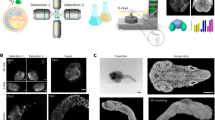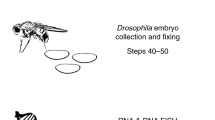Abstract
We describe a technique suitable for routine three-dimensional (3-D) analysis of mouse embryos that is based on episcopic fluorescence images captured during serial sectioning of wax-embedded specimens. We have used this procedure to describe the cardiac phenotype and associated blood vessels of trisomic 16 (Ts16) and Cited2-null mutant mice, as well as the expression pattern of an Myf5 enhancer/β-galactosidase transgene. The consistency of the images and their precise alignment are ideally suited for 3-D analysis using video animations, virtual resectioning or commercial 3-D reconstruction software packages. Episcopic fluorescence image capturing (EFIC) provides a simple and powerful tool for analyzing embryo and organ morphology in normal and transgenic embryos.
This is a preview of subscription content, access via your institution
Access options
Subscribe to this journal
Receive 12 print issues and online access
$209.00 per year
only $17.42 per issue
Buy this article
- Purchase on Springer Link
- Instant access to full article PDF
Prices may be subject to local taxes which are calculated during checkout





Similar content being viewed by others
References
McLean, M.R. & Prothero, J. Coordinated three-dimensional reconstruction from serial sections at macroscopic and microscopic levels of resolution: the human heart. Anat. Rec. 219, 434–439 (1987).
Laan, A.C. et al. Deformation-corrected computer-aided three-dimensional reconstruction of immunohistochemically stained organs: application to the rat heart during early organogenesis. Anat. Rec. 224, 443–457 (1989).
Verbeek, F.J. Three-dimensional reconstruction of biological objects from serial sections including deformation correction. Universiteit Delft, NL (1995).
Weninger, W. Computer-assisted three-dimensional reconstruction of histological section series. Universität Wien, A (1995).
Scarborough, J., Aiton, J.F., McLachlan, J.C., Smart, S.D. & Whiten, S.C. The study of early human embryos using interactive 3-dimensional computer reconstructions. J. Anat. 191, 117–122 (1997).
Streicher, J., Weninger, W.J. & Müller, G.B. External marker-based automatic congruencing: a new method of 3-D reconstruction from serial sections. Anat. Rec. 248, 583–602 (1997).
Streicher, J. et al. Computer-based three-dimensional visualization of developmental gene expression. Nature Genet. 25, 147–152 (2000).
Odgaard, A., Andersen, K., Melsen, F. & Gundersen, H.J.G. A direct method for fast three-dimensional serial reconstruction. J. Microsc. 159, 335–342 (1990).
Weninger, W.J., Meng, S., Streicher, J. & Müller, G.B. A new episcopic method for rapid 3-D reconstruction: applications in anatomy and embryology. Anat. Embryol. 197, 341–348 (1998).
Mohun, T.J., Leong, L.M., Weninger, W.J. & Sparrow, D.B. The morphology of heart development in Xenopus laevis. Dev. Biol. 218, 74–88 (2000).
Tjuvajev, J.G. et al. Imaging the expression of transfected genes in vivo. Cancer Res. 55, 6126–6132 (1995).
Tjuvajev, J.G. et al. Noninvasive imaging of herpes virus thymidine kinase gene transfer and expression: a potential method for monitoring clinical gene therapy. Cancer Res. 56, 4087–4095 (1996).
Gambhir, S.S. et al. Imaging adenoviral-directed reporter gene expression in living animals with positron emission tomography. Proc. Natl Acad. Sci. USA 96, 2333–2338 (1999).
Smith, B.R. Visualizing human embryos. Sci. Am. 280, 76–81 (1999).
Louie, A.Y. et al. In vivo visualization of gene expression using magnetic resonance imaging. Nature Biotechnol. 18, 321–325 (2000).
Spoor, F., Jeffery, N. & Zonneveld, F. Using diagnostic radiology in human evolutionary studies. J. Anat. 197, 61–76 (2000).
Hecksher-Sørensen, J. & Sharpe, J. 3-D confocal reconstruction of gene expression in mouse. Mech. Dev. 100, 59–63 (2001).
Dunwoodie, S.L., Rodriguez, T.A. & Beddington, R.S.P. Msg1 and Mrg1, founding members of a gene family, show distinct patterns of gene expression during mouse embryogenesis. Mech. Dev. 72, 27–40 (1998).
Webb, S., Brown, N.A. & Anderson, R.H. Cardiac morphology at late fetal stages in the mouse with trisomy 16: consequences for different formation of the atrioventricular junction when compared to humans with trisomy 21. Cardiovasc. Res. 34, 515–524 (1997).
Summerbell, D. et al. The expression of Myf5 in the developing mouse embryo is controlled by discrete and dispersed enhancers specific for particular populations of skeletal muscle precursors. Development 127, 3745–3757 (2000).
Anderson, R.H., Webb, S. & Brown, N.A. The mouse with trisomy 16 as a model of human hearts with common atrioventricluar junction. Cardiovasc. Res. 39, 155–164 (1998).
Acknowledgements
We are grateful to D. Summerbell, J.P. Martinez-Barbera and N. Brown for providing transgenic embryos; S. Pagakis for assistance with computing; and R. Chillingworth and J. Sawkins for technical assistance.
Author information
Authors and Affiliations
Corresponding authors
Rights and permissions
About this article
Cite this article
Weninger, W., Mohun, T. Phenotyping transgenic embryos: a rapid 3-D screening method based on episcopic fluorescence image capturing. Nat Genet 30, 59–65 (2002). https://doi.org/10.1038/ng785
Received:
Accepted:
Published:
Issue Date:
DOI: https://doi.org/10.1038/ng785
This article is cited by
-
Correlative microscopy and block-face imaging (CoMBI): a 3D imaging method with wide applicability in the field of biological science
Anatomical Science International (2023)
-
Correlative microscopy and block-face imaging (CoMBI) method for both paraffin-embedded and frozen specimens
Scientific Reports (2021)
-
3D computational reconstruction of tissues with hollow spherical morphologies using single-cell gene expression data
Nature Protocols (2015)
-
Three-dimensional reconstruction of light microscopy image sections: present and future
Frontiers of Medicine (2015)
-
A detailed comparison of mouse and human cardiac development
Pediatric Research (2014)



